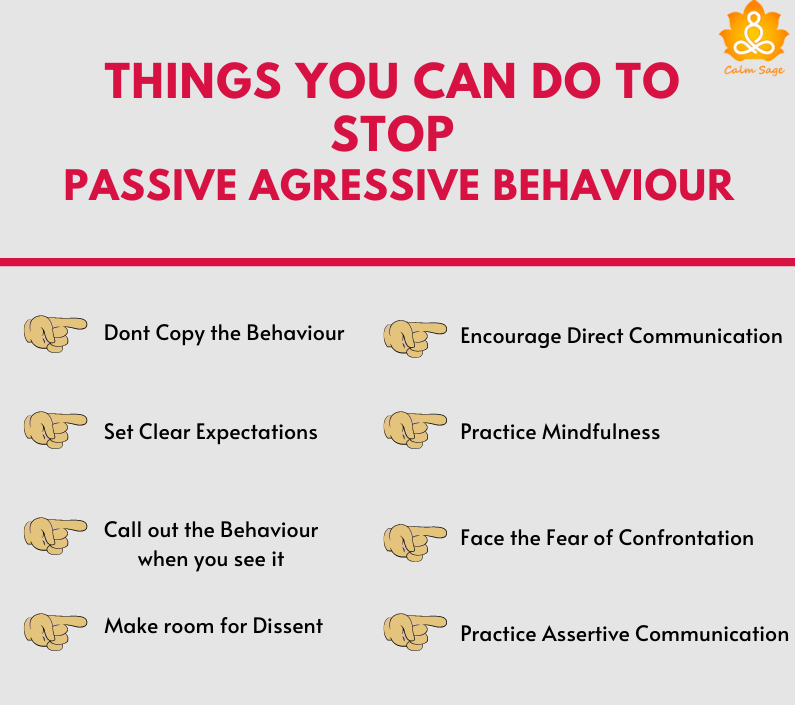Passive Aggressive Behavior: Signs, Causes and How To Respond

Have you ever responded to someone with indirect aggressiveness? Or responded to an inquiry with something akin to aggression but yet not at the same time? This kind of behavior is often referred to as “passive-aggressive behavior” and can appear as one being uncharacteristically stubborn, being sulky, or procrastinating on tasks.
We’ve all run out of patience at one point in life and in some situations, we’ve responded to feelings such as disappointment with, “Sure, whatever” or “It’s OK” but inside, we’ve felt the opposite of fine.
This is what passive-aggressive behavior looks like. It involves subtly expressing your strong feelings and emotions such as disappointment, anger, and irritation through not-so-subtle actions instead of talking about them or responding directly to them.
Here, we’re exploring more about passive-aggressive behavior, the causes behind it, the signs of passive-aggressive behavior, and how you can respond to the behavior.
What Is Passive Aggressive Behavior?

The kind of behavior where you express your negative emotions or feelings in an indirect manner rather than being straightforward and open about it can be called being “passive-aggressive”.
There are signs of anger, disappointment, and frustration but the words are quite opposite and include things like “Ya, that’s just fine” or “Whatever, you do it”.
Here’s one passive-aggressive example; A woman is angry at her partner. However, instead of addressing the problem openly, she creates a fuss about playing loud television or loud music or complaining about others.
Similarly, if your coworker is asking you to do something needlessly, instead of clearing the situation with them, you start sending taunts as passive-aggressive compliments or start showing passive-aggressive behavior.
Passive-aggressive behavior means expressing yourself in indirect aggression rather than being upfront and direct. People dealing with passive aggression or passive-aggressive personalities often find it painful to confront their anger, emotions, or disappointments.
Although you may find passive-aggressive behavior appropriate to control a situation, it somewhere depletes the relationship as well as is devoid of the chance of addressing the real problems.
If we understand the examples of passive-aggressive personality to elaborate on passive aggression meaning:
- An individual avoids someone constantly expressing their dislike towards them rather than explaining the causes and feelings.
- Telling everyone that you are fine and refusing to open up the problems and solve them.
What Are The Causes Of Passive Aggressive Behavior?
There are different reasons why you might act differently under aggression and avoid confronting the emotions. Some causes of passive-aggressive behavior include:
1. Fear of loss and authority:
Fear of losing an opportunity in the workplace, getting punished, or losing someone you love may become the cause of hiding emotions.
2. Poor communication:
Not everyone can manage direct communication because of shame or prevention of conflict and they use passive aggression as expression.
3. Environment:
Those who grew up in an environment where the parents have used similar expressions tend to follow the same path and may have a passive-aggressive disorder or may become more prone to passive-aggressive behavior.
4. Shameful of own emotions:
Some people are ashamed to show their emotional communication or express their feelings as they are not able to admit them. This may also cause many to resort to passive-aggressive behavior to cope.
After understanding the reasons for being passive-aggressive, let us find out the signs of the behavior and if you are using it to cope with it.
7 Signs You Are Using Passive Aggressive Behavior

1. Giving Silent Treatment:
You could say “I am upset because you did this. Can you explain?” but under aggression, it is more likely that you don’t reply or just roll your eyes in response.
2. Giving Backhanded Compliments:
Your compliments would look good if you say ‘Beautiful dress’. But their value could vary when you say “Beautiful dress. I saw it in a nearby mall at a very low price.” It shows your competitiveness and unhappiness at a certain point and is a major sign of passive-aggression.
3. Talking Negatively:
Speaking negatively about someone behind their back without addressing the problem. You may complain about a situation with others to indirectly express your unhappiness and discontentment.
4. Leaving Work Incomplete:
Not completing your work or leaving it in an ‘almost’ state is also a sign that passive-aggressive behavior is about. You will do the laundry but would avoid folding or you may decide to clean the dishes but leave them filled with water.
5. Invalidating Actions:
If you’re passive-aggressive then you would add invalidating comments within a productive conversation. For example, “You must have not cleaned your room because you were playing games all day long.” This shows passive-aggressive behavior.
6. Deliberately Annoying:
Running late deliberately and making other people wait to annoy them. When you are exhibiting passive-aggressive behavior, you’re likely to annoy others by slamming doors, being late to meetings, sighing loudly, or pouting on purpose to convey your unhappiness.
7. Shifting Blame On Others:
Passive-aggressive signs also include shifting the blame on someone else for their circumstances. For example, “I couldn’t finish my work because you took me out shopping.”
The above are some signs of passive-aggressive behavior and if you or your loved ones are showing some of them then it’s time to understand how to deal with the situation of being passive-aggressive.
How To Deal With Passive-Aggressive Behaviour?

“Am I passive-aggressive?” Well, if you find the signs of passive-aggressive behavior within you and wish to resolve it then answer a few questions. Mind you, you need to be mindful of your actions, empathetic, and may need to take a step back for recognition.
- Are you avoiding people with whom you are upset?
- Do you undertake activities that can make others feel punished?
- Do you use sarcasm and avoid indulging in meaningful conversations?
If you answered “yes” to any of the above questions, then these steps may help you to cope with passive-aggressive behavior subsequently.
1. Give yourself time to change your behavior after realizing it. Altering the pattern is time-consuming, all you have to do is become a little more empathetic and take your actions cautiously.
2. Self-awareness and mindfulness. are those tools that keep you attentive not only to your actions but also to others’ views. Once you learn their perspective of your actions, you make decisions in a better way.
3.Try to express yourself appropriately. If it is needed, write down your thoughts and emotions on a piece of paper and share it with the person.
How To Respond To Passive-Aggressive Behavior?

When you’re confronted with a partner, family member, or coworker who frequently responds with passive-aggressiveness, then what can you do? Well, the first step is to look for signs of passive-aggressive behavior. Are they sulking or pouting to express their discontentment? Are they deflecting by using backhanded compliments?
Once you identify the signs, you’ll likely feel angry. Keep your anger in check and try to calmly respond to their feelings by being non-judgmental. If your child is being passive-aggressive about doing chores, then you can respond with, “You seem angry at me because I asked you to do your chores.”
Address their passive-aggressive behavior without directly blaming them. This calm response to their passive-aggressiveness can sometimes make it easier for them to communicate with you. It also allows them to understand their passive-aggressive behavior and that you are not going to let their behavior slide.
In the end, all you need to do is allow them a safe space where they can talk about their feelings. Give them the time and space to work through their emotions and how they can handle them.
Why Passive Aggressive Behavior Bad For Your Health?
Passive aggressive personalities hold a feeling of resentment towards others and it acts as a blockage in expression. Their actions are also communicated in passive-aggressive communication. Such behavior of passive-aggressive personality builds a wall between two parties and the issue remains unresolved until expressed.
Moreover, if it continues in a long-term relationship then only either one of the two survives. It also acts as a mental barrier and all the productive thoughts are guided toward unnecessary arguments.
When you’re being passive-aggressive, then it can reflect on your relationships, negatively. Because you are reluctant to open up about your feelings and communicate clearly, the people around you might not understand why they are being treated coldly. This can confuse and drive a wedge in your relationships.
Unaddressed passive-aggressiveness can eventually take a toll on your overall health. Your partner, for instance, may tire of asking what they can do and eventually begin to resent the response you give.
And since you’re reluctant to open up about your emotions, the anger and disappointment that festers are never expressed.
Not only romantic relationships but eventually passive-aggressive behavior may take a toll on your academic performance, work productivity, and family relationships as well.
Frequently Asked Questions
Q1. What Are Some Signs of Aggressive Behavior?
Some common signs of passive aggression are anxiety, frequent mood changes, depression, memory issues, trouble in organizing thoughts, and poor communication skills.
Q2.What Are Physical and Verbal Signs of Aggressive Behavior?
Aggressive disorder depicts signs like raised voice, clenched fists, hitting things away, throwing off items in the room, expressing your thoughts and swearing in again and again.
Q3. What Triggers Aggressive Behavior?
Some triggering reasons behind passive aggressive behavior is embarrassment, humiliation, insult in front of others, afraid of emergency situations and rejection by others.
Wrap-Up
The rules of life are very simple. Express yourself, release your emotions, and live your life freely. Once you understand the concept, it becomes easier for you to cut down passive-aggressive behavior as well as the negatives associated with it.
We are hopeful that you would keep your calm maintained and work on the behavior positively.
For more, you can write to us at info@calmsage.com or DM us on social media. You can also share your thoughts on this article in the comments section below.
Take Care!





















Awesome piece so educational.. informed and inspiring